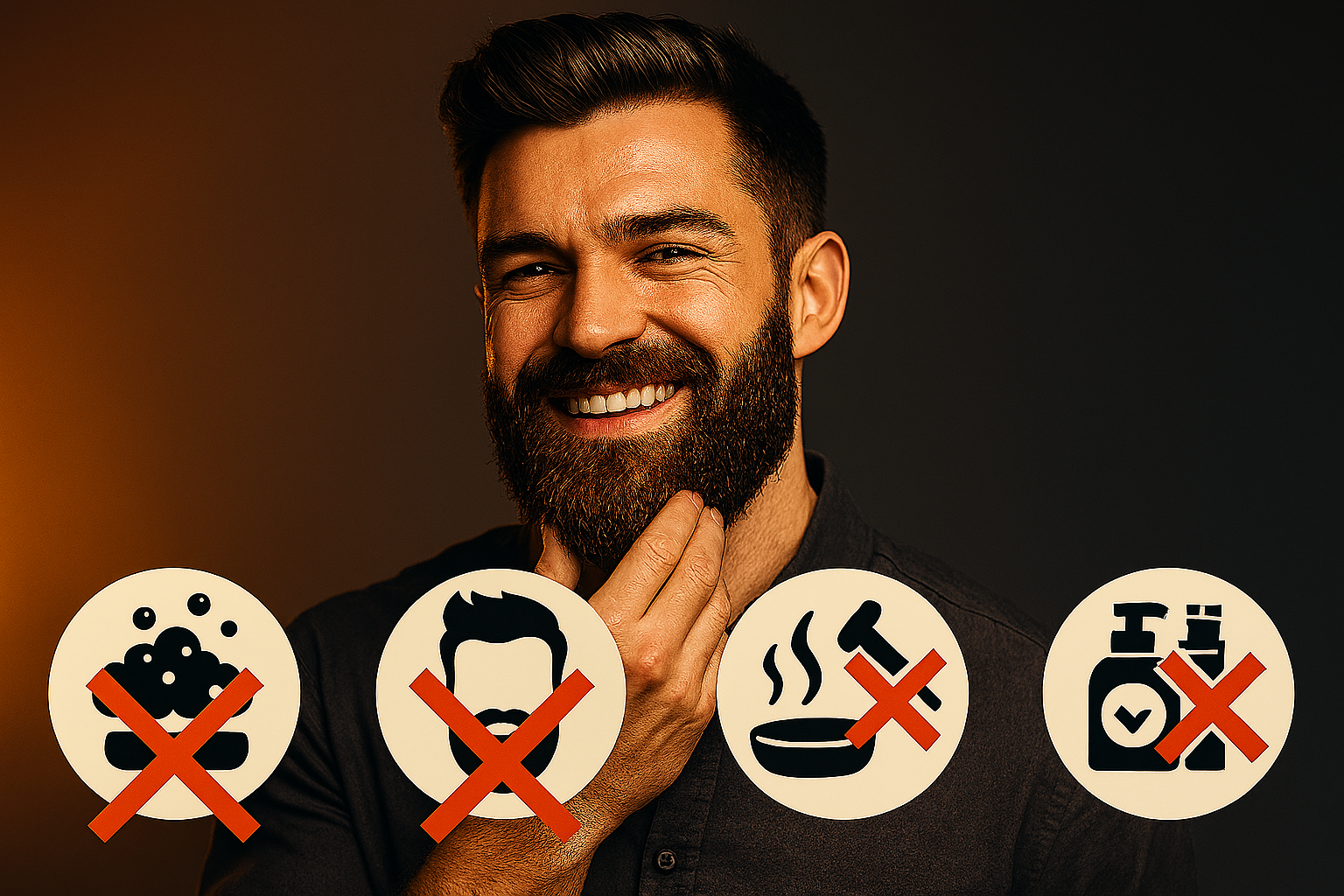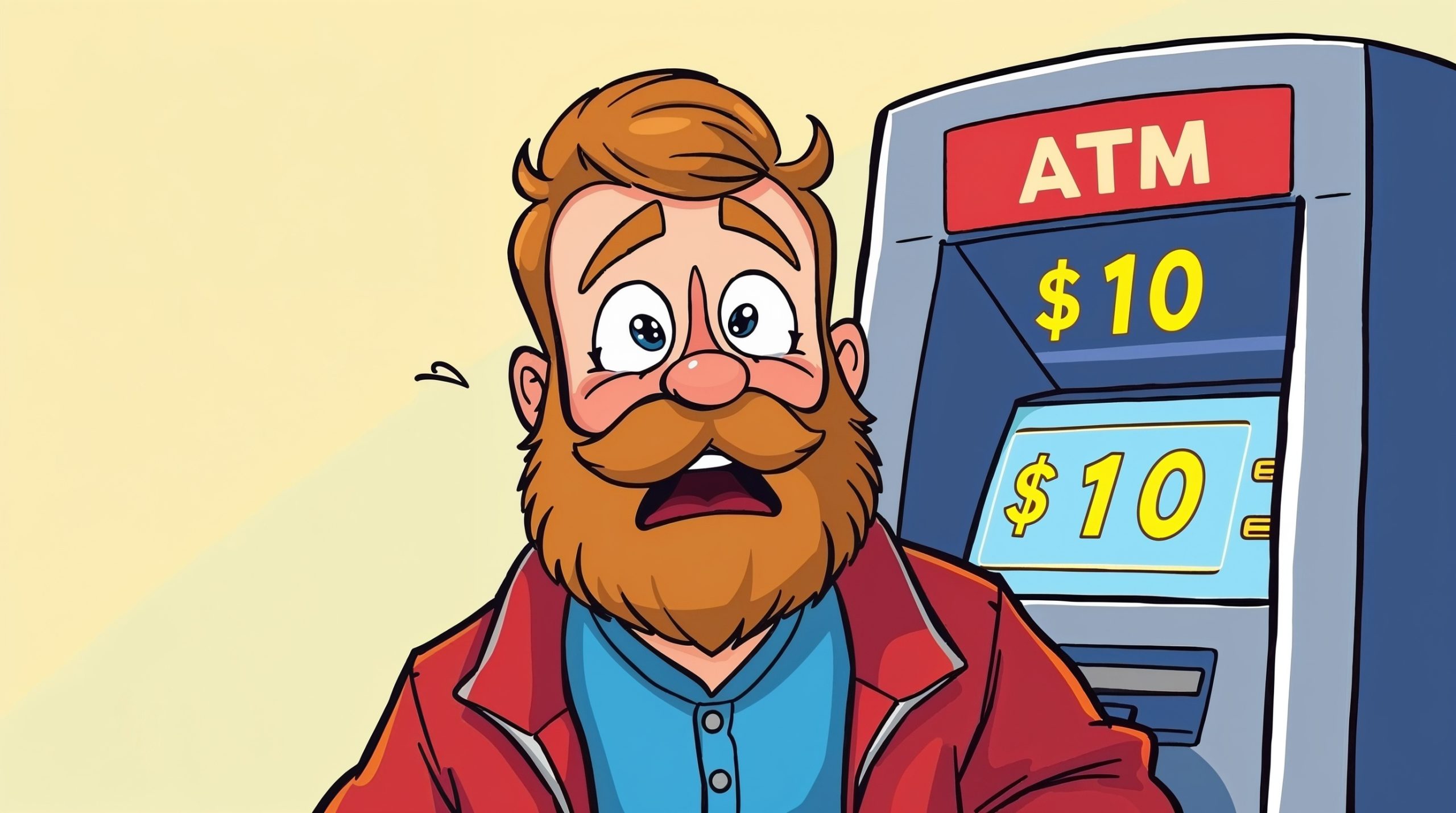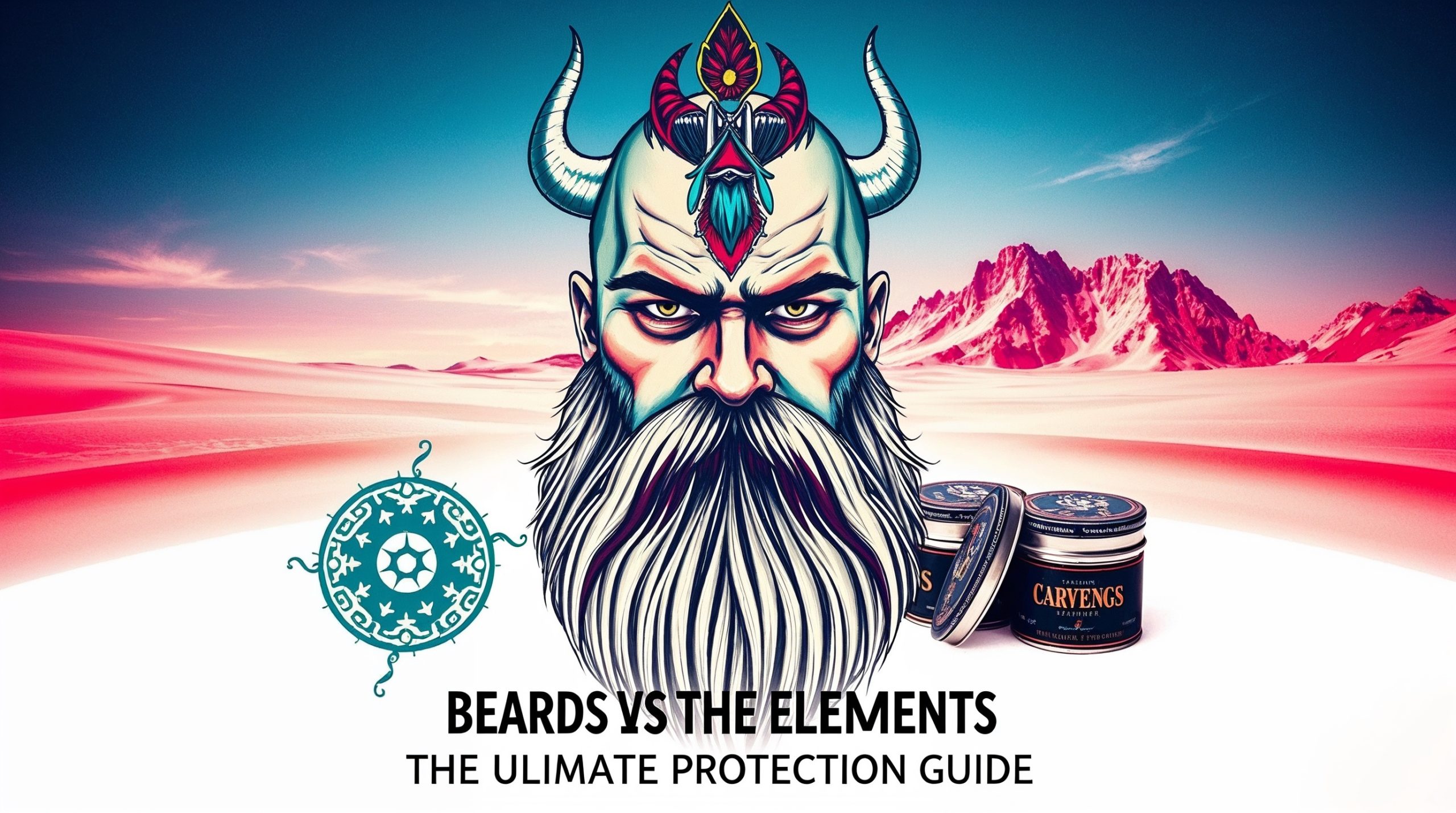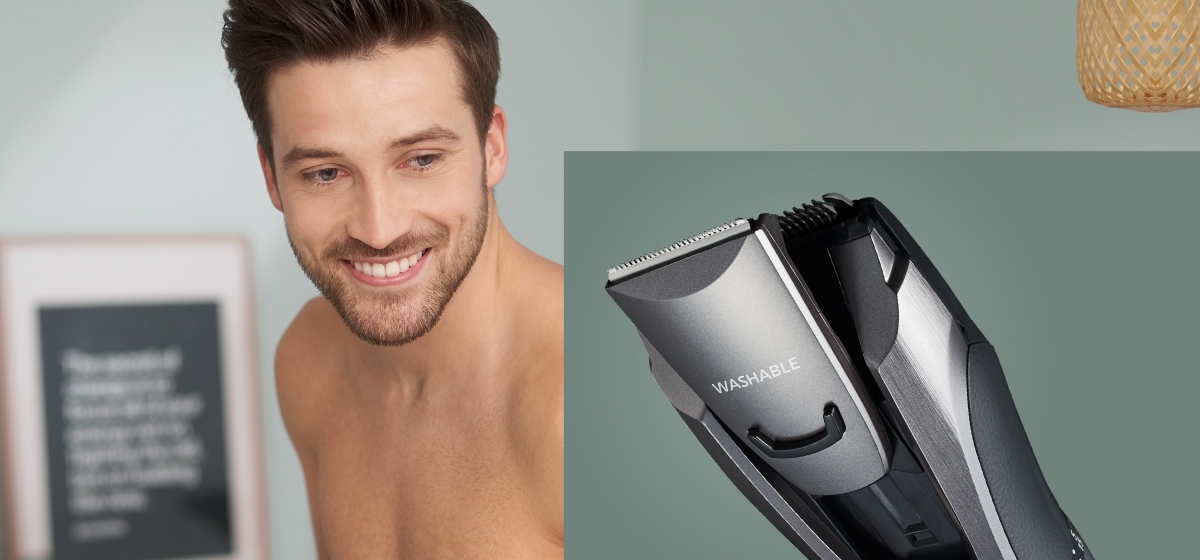Last updated: September 2025
Let me guess—you’re sitting there right now, trying not to scratch your face like a bear against a tree. Your beard feels like it’s made of tiny needles stabbing your skin, and you’re about three seconds away from grabbing the razor and ending this whole experiment.

Hold up, warrior. Put down the razor and step away from the bathroom mirror.
That itchy beard driving you insane? It’s not just you. In fact, 92% of men experience significant beard itch during their first month of growth, and even seasoned beard veterans still battle the scratch from time to time. The good news? This torture chamber on your face is completely fixable, and I’m about to show you exactly how to turn your face cactus into a majestic, itch-free mane.
The Science Behind the Scratch (Or Why Your Face Hates You Right Now)
Before we dive into solutions, let’s understand why your beard is staging this rebellion against your face. Knowledge is power, and in this case, it’s the power to stop looking like you have fleas at that important work meeting.
1. The Sharp Shooter Problem
When you shave, you’re essentially creating thousands of tiny spears pointed directly at your face. No, seriously—look at a shaved hair under a microscope and it looks like a medieval weapon. As these hairs grow out during the first few weeks, they curve back and literally poke your skin. It’s like sleeping on a bed of really tiny, really annoying nails.
This is why new beard growers suffer the most. Your face isn’t trying to sabotage your rugged new look—it’s just dealing with an army of microscopic daggers. The good news? After about 4-6 weeks, these hairs soften and the tips become less sharp. The bad news? That’s 4-6 weeks of wanting to claw your face off.
2. The Sahara Desert Situation
Here’s something most guys don’t realize: growing a beard is like suddenly adding a moisture-sucking sponge to your face. Your beard hairs are thirsty little vampires that steal all the natural oils from your skin, leaving it drier than your humor at Monday morning meetings.
Your skin normally produces sebum (natural oil) to keep itself moisturized. But now those oils have to travel further to reach the skin surface, and your beard hairs are greedily absorbing them along the way. The result? Dry, flaky, itchy skin that makes you want to scratch like you’ve got chicken pox.
3. The Bacterial Block Party
I hate to break it to you, but your beard is basically a nightclub for bacteria. And unlike the cool nightclubs you pretend to enjoy, this one’s causing problems. Dead skin cells, food particles (yes, that lunch burrito counts), and bacteria all get trapped in your facial forest.
Without proper cleaning, these party crashers irritate your skin and cause—you guessed it—more itching. It’s like having microscopic squatters on your face who refuse to pay rent and make everything uncomfortable.
4. The Product Predicament
Using regular soap or shampoo on your beard? Congratulations, you’re making it worse. These products strip away natural oils faster than a NASCAR pit stop, leaving your skin crying out for moisture. Your head hair and beard hair are as different as craft beer and Bud Light—they need completely different treatment.

The Geography of Itch: Why Some Areas Are Worse Than Others
Ever notice how the itch isn’t uniform? There’s a reason your neck feels like it’s hosting a cactus convention while your cheeks are relatively chill.
The Neck Zone of Death: This area gets it worst because the hairs grow in multiple directions, skin is more sensitive, and it’s where your collar rubs all day. It’s basically the Bermuda Triangle of beard itch.
The Mustache Madness: Food particles, drinks, and constant moisture from breathing make this area a special kind of itchy hell. Plus, those hairs love to curl back and poke your upper lip like tiny, persistent bullies.
The Jawline Junction: Where your beard meets smooth skin, there’s a constant battle happening. The contrast in hair density creates an itch gradient that’ll drive you nuts.
The 7-Step Battle Plan to Defeat Beard Itch Forever
Alright, enough about why you’re suffering. Let’s talk solutions. Follow this battle plan and you’ll go from scratchy disaster to smooth operator faster than you can say “lumberjack chic.”
Step 1: Wash Like You Mean It (But Gently)
First things first—you need to evict those bacterial squatters. But here’s the catch: you can’t use that 3-in-1 shampoo-conditioner-body wash-engine degreaser you’ve been using since college.
Wash your beard 2-3 times per week with lukewarm water and a proper beard wash. Hot water might feel good, but it strips oils faster than a Vegas casino strips wallets. When washing, really get in there with your fingertips (not nails!) and massage the skin underneath. Think of it as giving your face a spa day, not scrubbing a dirty pan.
Step 2: Exfoliate Like a Boss
Once a week, you need to evict the dead skin cells throwing a party in your beard. Use a soft-bristled brush or a beard-specific exfoliating scrub. This isn’t the time to channel your inner Hulk—gentle circular motions will do the job without turning your face into a crime scene.
Pro tip: Do this before you shower. Dry brushing loosens everything up, then the shower washes it all away. It’s like a two-stage rocket for skin cell removal.
Step 3: The Oil is Essential (Literally)
This is where the magic happens, gentlemen. Beard oil isn’t some hipster snake oil—it’s literally the difference between looking like a majestic Viking and looking like you lost a fight with a thornbush.
After years of testing everything from drugstore basics to artisanal oils that cost more than my monthly coffee budget, I’ve found the holy grail: Medicine Man’s Anti-itch Beard Oil. This stuff is specifically formulated to combat itch, not just make you smell like a lumberjack’s Pinterest board.
What makes it different? It contains tea tree oil (natural anti-bacterial), peppermint oil (cooling and soothing), and jojoba oil (mimics your skin’s natural oils). It’s like sending in a SWAT team to deal with your itch problem. Plus, at around $15-20 on Amazon, it won’t require you to take out a second mortgage.

HELPS RELIEVE BEARD ITCH – Medicine Man’s Itchy Beard Oil, conditioner & moisturizer powered by healing Castor Seed Oil
STIMULATES BEARD GROWTH – Has Burdock Root Oil known to strengthen & promote natural hair growth
HELPS CONTROL BEARD DANDRUFF – Rich in Vitamin E – Nourishes damaged follicles & patchy beards – good for beard growth
Apply 3-4 drops right after showering while your beard is still slightly damp. Rub it between your palms and work it through your beard, making sure to massage it into the skin underneath. This is crucial—the oil needs to reach your skin, not just sit on your beard making it shiny.
Step 4: Brush It Out
Invest in a quality boar bristle brush. Not only does it help distribute oils evenly, but it also trains your beard hairs to grow in the right direction (away from your skin, not toward it like tiny torture devices).
Brush gently from top to bottom, following your beard’s natural growth pattern. Do this daily, preferably after applying oil. It’s like combing your beard’s hair while giving your face a mini massage. Win-win.
Step 5: Stay Hydrated (Inside and Out)
Drinking water isn’t just good for your Instagram wellness posts—it actually helps with beard itch. Dehydrated skin is itchy skin, and no amount of external products can fix internal dehydration.
Aim for 8-10 glasses of water daily. If plain water bores you to tears, throw in some lemon or cucumber. Just stay hydrated. Your beard (and your kidneys) will thank you.
Step 6: Diet Matters (Sorry, Pizza Lovers)
Your beard health is directly connected to what you stuff in your face. Omega-3 fatty acids (found in fish, nuts, and seeds) help keep skin moisturized from the inside out. Vitamins A, C, and E are like internal beard conditioners.
I’m not saying you need to become a kale-smoothie-drinking yoga instructor. Just maybe add some salmon to your diet and eat a vegetable that isn’t deep-fried occasionally. Your beard will notice the difference.
Step 7: Patience, Young Padawan
Here’s the truth bomb nobody wants to hear: sometimes you just need to wait it out. The first 4-6 weeks are the worst. After that, your skin adapts, your beard softens, and the itch naturally decreases.
Think of it like going to the gym. The first few weeks are torture, everything hurts, and you question your life choices. But push through, and suddenly you’re that guy who actually enjoys working out (weird, right?).

The Emergency Itch Protocol
Sometimes, despite your best efforts, the itch strikes with the fury of a thousand angry bees. Here’s your emergency response plan:
- Cold Compress: Wrap some ice in a clean cloth and apply to the itchy area for 30 seconds. It numbs the itch and reduces inflammation.
- Apple Cider Vinegar Rinse: Mix 1 tablespoon with a cup of water, apply to your beard, leave for 2 minutes, then rinse. It’s like a reset button for your skin’s pH.
- Aloe Vera Gel: Pure aloe vera gel (not the sunburn stuff full of alcohol) provides instant cooling relief. Keep some in the fridge for extra soothing power.
- Resist the Scratch: Scratching makes it worse by irritating the skin further and potentially causing infection. When you feel the urge, apply oil instead. Train your brain: itch equals oil time, not scratch time.
Common Mistakes That Make Beard Itch Worse
Let’s talk about what NOT to do, because sometimes knowing what to avoid is just as important as knowing what to do.
The Over-Washer: Washing your beard daily with regular shampoo? You’re stripping away oils faster than a toddler strips off clothes at bath time. Twice a week is plenty unless you work in a coal mine.
The Neglector: On the flip side, never washing your beard is like never washing your dishes—things get gross fast. Find the balance.
The Hot Water Junkie: I get it, hot showers feel amazing. But they’re murder on your beard. Turn down the temperature when washing your face, even if the rest of your shower could cook pasta.
The Aggressive Dryer: Rubbing your beard dry with a towel like you’re trying to start a fire? Stop. Pat it dry gently or you’ll irritate the skin and create more itch.
The Product Overloader: Using seventeen different products won’t make your beard grow faster or itch less. Start simple: wash, oil, brush. That’s it.

The Seasonal Itch Guide
Different seasons bring different challenges. Here’s your year-round game plan:
Winter: Cold air and indoor heating are moisture vampires. Up your oil game and consider a humidifier for your bedroom. Your beard (and sinuses) will appreciate it.
Spring: Allergies can make beard itch worse. Wash your beard before bed to remove pollen, and consider an antihistamine if things get really bad.
Summer: Sweat and sunscreen can clog pores and increase itch. Wash more frequently (but still gently) and consider a lighter oil formula.
Fall: The transition to drier air can trigger itch. Start increasing your moisturizing routine before winter hits full force.
When to Wave the White Flag
Look, sometimes beard itch is more than just normal growing pains. If you experience any of these, it’s time to see a dermatologist:
- Severe redness or swelling
- Oozing or crusting
- Itch that keeps you awake at night
- Bald patches appearing
- Itch that doesn’t improve after 2-3 months
These could signal conditions like seborrheic dermatitis, fungal infections, or allergic reactions that need professional treatment. There’s no shame in getting help—even Vikings had healers.
The Final Verdict
Beard itch is like that annoying coworker who microwaves fish in the office—temporarily unbearable but ultimately manageable with the right approach. The key is consistency and using the right products for YOUR beard, not what worked for your buddy with different skin type.
My personal game-changer was switching to Medicine Man’s Anti-itch Beard Oil. After trying everything from coconut oil (too heavy) to expensive boutique brands (too pretentious), this struck the perfect balance of effectiveness and affordability. It specifically targets itch rather than just making your beard soft, which is exactly what you need during those brutal first months.
Remember, every magnificent beard you see went through the itchy phase. That guy with the glorious facial mane at your coffee shop? He scratched too. The bearded model in that craft beer ad? Yep, he’s been there. You’re not alone in this follicular struggle.
Stick with it, follow the plan, and in a few weeks you’ll be stroking your itch-free beard thoughtfully while dispensing wisdom to other itchy-faced newcomers. The brotherhood of the beard awaits, my friend. Don’t let a little itch stop you from joining our gloriously bearded ranks.
Now if you’ll excuse me, I need to oil my beard. It’s been exactly 3.5 hours since my last application, and I have standards to maintain.
Beard Itch FAQ: Your Burning Questions Answered
Have you conquered the dreaded beard itch? What worked for you? Drop your beard wisdom in the comments below and help a itchy brother out. And remember, a beard without itch is just… a beard. But a beard that survived the itch? That’s a story worth telling.




